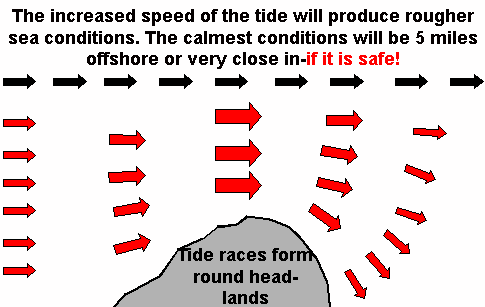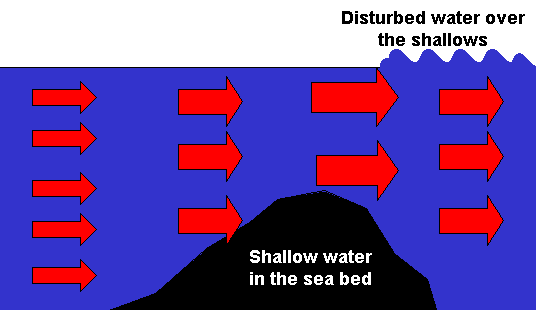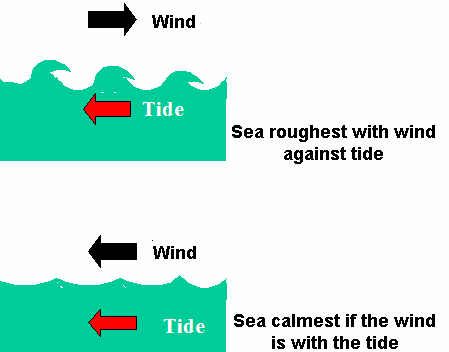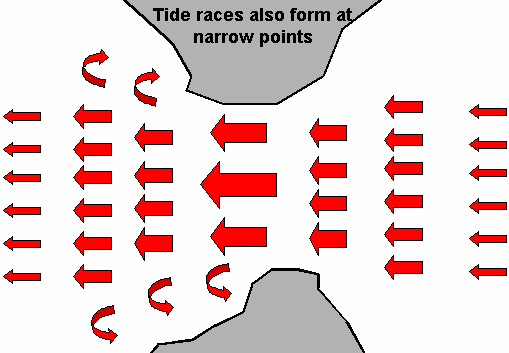Navigation and Chart work - Tidal hazards
Tidal Races
When the tide runs it can affect the sea-state and produce either calmer or rougher conditions than expected.
On some charts there is a warning about tide races in the area covered by that chart, these can be potentially dangerous places, yet many small craft sail in these areas every year. They can only do so by understanding the forces involved.

Off virtually any headland you can expect some sort of race when the tide runs, some of these races are minor but most require some care. If they are passed at least 5 miles offshore the vessel is normally outside the danger area. Some headlands can be passed very close to the shore, where there may be an area of calmer conditions at certain times of the tide, these passages should only attempted by experienced sailors or those with local knowledge.
Tide races will occur anywhere that the speed of the tide is accelerated by a constriction, such as a headland or narrowing in the channel. This increase may produce currents of 10 or more knots in localised areas, probably far more than the official information indicates. In these conditions great care must be taken with the navigation as the vessel's position may be changing too fast for conventional navigation techniques.
When cruising in the Channel Islands I have on several occasions had a ground speed in excess of 15 knots when sailing at only 5 knots!
Overfalls
A similar feature is an area of overfalls.
Overfalls will occur when the tide flows over a shallow patch on the seabed, often this is within a tide race! The rough water is normally found on the down tide side of the obstruction.
![]()
![]()
Tide races and over falls are marked by these symbols.
On Chart 3, find Fiddler's Race (45°47.0'N 05°44.0'W), you can see there are several places with these symbols. Anywhere called "Race" should be regarded as potentially hazardous in the wrong conditions.
Wind and tide conditions
The direction of the wind relative to the tide will have a major effect on the sea state experience.
When the wind blows against the tide the waves become steeper and break, but when the tide turns the waves flatten and lengthen giving much more pleasant conditions.

This effect can change the sea state enormously and in strong winds should always be considered.
On top of this, the skipper needs to consider the effect of shelter and exposure to the wind direction. In an area like the Solent , the conditions in the Western Solent will be very different to the Eastern Solent when there is a strong southwesterly wind blowing.
Passages against the tide
Normally we would say that a passage should be made with the tide whenever possible.
However, in a motor vessel the difference in the boat's speed in flat water and rough water may be considerable, there may be a reduction from 20 knots to 5 knots. It this situation it may be advantageous to make a passage against the tide if by waiting for the tide to be with the direction of the passage, this meant that the tide would be against the wind. The loss of a couple of knots of tide may be far outweighed by the increased speed and comfort of the passage.
This is rarely going to apply when sailing.
Visibility
One of the effects on the turbulence in a tide race or near overfalls is that cold water can be brought up in upwellings from near the bottom to the surface of the sea. If the conditions for fog forming are marginal, such as when fog banks are forecast, it is likely that this drop in sea temperature would produce fog banks over the disturbed water, just where you do not want it!
Harbour Bars
If a harbour has a bar on the entrance it should be treated with caution. Much of the time you will be able to pass over the bar with no problem but in the wrong conditions it could easily lead to the loss of the vessel.
A bar is a shallow entrance normally found just outside the harbour entrance which may be quite deep. The danger of this shallow area is that when there is an onshore wind waves will break right across the entrance to form surf. This can occur even when there is no wind if there is a large swell running on to the bar. A good example is found on Chart 4E, Namley Harbour.
If the tide is flowing strongly out of the harbour such as on the spring ebb tide this effect is exaggerated and the waves will be very close together and may produce conditions which no yacht could survive.
One of the most dramatic entrances over a bar is found on the Columbia River, a collection of photos are available here.
Warnings of tide race and overfalls
We have seen two of the clues that there may be unusual tidal conditions in an area, either the symbols above or the warning given on the chart. Other sources of information are the Almanac and Yachtsmen's Pilot Books. Both of these give passage-planning information, and anyone venturing in to an unfamiliar area must read these publications.
Find page 69 of the Training Almanac. There is a section on the Fiddler's Race giving details of when it is best to pass through and when not to be there! In difficult areas like this it is likely that someone has already worked out when to pass through, you just need to do a bit of research to find out when.
On page 52 of the Training Almanac, is information from an almanac covering the entrance to Namley Harbour: This gives the details of the dangers of the bar at the harbour entrance.
In the absence of this sort of data the times to avoid tide races or overfalls are:
• In strong winds.
• When the wind is blowing against the tide.
• When the tide is at its strongest.
The safest times to pass through a tide race are:
• When the tide is slack.
• When the wind is with the tide.
• At least 5 miles offshore or very close in, but only if you know the waters.
Provided you follow these guidelines there is nothing to fear, and you will be able to be tied up in harbour before the sea-state becomes unpleasant or dangerous.
Some of the most impressive tide races in the UK are:
Gulf of Corrievreckan (Between Scarba and Jura).
Additional Resources:


